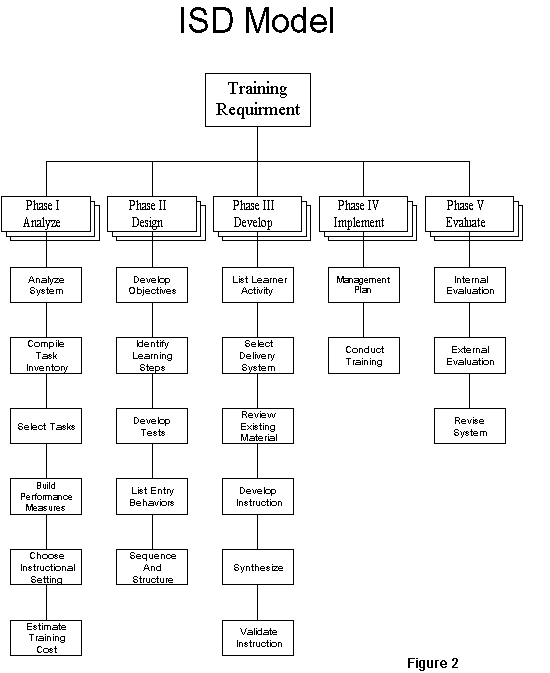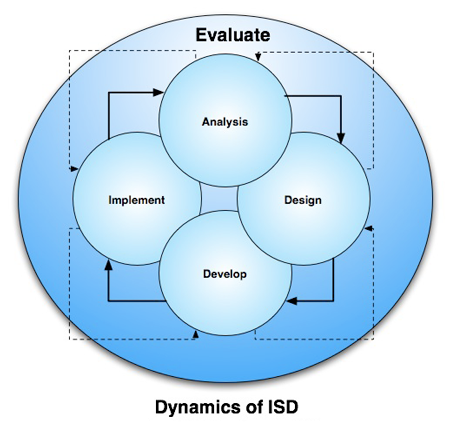Critiquing Instructional System Design
Some of the benefits of ISD (Instructional System Design) or ADDIE are characteristic of all systematic approaches. The ISD model is a management tool that makes the creation of training/learning platforms or processes more effective and efficient. Effective learning and performance solutions are more likely because the ISD model increases the probability that the courseware will match the objectives and not veer off in a different direction (Roblyer, 1981). The courseware can then be improved and strengthened through data collection and analysis to make it more efficient.
ISD is Dynamic, not Linear
The ISD model has been criticized because it is frequently presented in flowchart form, leaving the impression that it is mechanistic and linear in its approach:

While U.S. Armed Forces instructional designers have been using ADDIE or ISD as a dynamic concept since the mid 80s, it seems as if many of their civilian counterparts are still stuck on the notion that it is linear in nature.
I have tried to point out in earlier sections that it is not a mechanical, algorithmic, step-by-step procedure, but rather a exploratory problem solving technique that uses evaluation and feedback, which in turn, makes it quite iterative (van Merriënboer, 1997; U.S. Army Field Artillery School, 1984; also see ADDIE Timeline). Thus, it improves performance by being a heuristic model.
The above model is best used for showing its steps, while the below model is best used for showing its dynamic nature.

Heuristic Design
It is this heuristic design that has been criticized by others because it tells designers what to do, but not how to do it. This argument is not entirely valid because there is a considerable body of educational, learning, and training literature (to include this manual) that tells how to perform the various processes in the ISD model.
Process Model
Recently, some have been calling ADDIE (ISD) a process model that can be used for a number of outcomes, such as building a house, strip mall, or a web site. A true ISD model, on the other hand, is limited to instructional outcomes.
I can honestly tell you that you cannot even build a shed in your backyard using ADDIE, much less a house, strip mall, or web site (besides being an instructional designer, I am also a retired Army engineer). In their rush to criticize ADDIE and ISD, people seem to either forget that there are major steps and processes within ADDIE that are strictly related to instructional design, or they have no idea what ADDIE is.
I think we should remember that the U.S. Armed Forces has been using the ADDIE model just as the Vietnam war was coming to an end and are still using it quite successfully today.
Provides Basic Procedures
A frequent criticism is that it is too time-consuming to be practical in the real world. Yet, not knowing the basic procedures for building a learning process or platform leads many novices down the wrong path, which wastes even more resources. Additionally, it provides all instructional designers, from novice to expert, with a common set of terms and processes to communicate effectively with each other.
Top-Down
Some say that systematic models take a top-down behaviorist and subject-matter-expert approach to learning instead of championing a constructivist approach. However, training has traditionally been task driven by discovering how experts performs their jobs and then mirroring this performance in the learning environment. Also, nothing says a constructivist method cannot be used for learning the task — don't complain that ADDIE made me do it.
For more critiques, see The Attack on ISD. To see how ISD or ADDIE has grown, see the ADDIE Timeline.
No single model is the silver bullet of instructional design, including ADDIE. Each model has its advantages and disadvantages. However, designers can come closer to that silver bullet by using the key advantages of a system model and then plugging other models into it to improve their design or using a different design models.
Comparing ISD with Other Models
It often helps to understand a model better by looking at other models:
Evolutionary Model
An evolutionary (iterative) approach includes both deterministic and incremental systems, in contrast to the systems approach, which starts as a deterministic model and then changes to an iterative model to improve the chance of success.
This means that in an evolutionary approach, tentative or short-term goals may be specified. This approach is particularly appropriate for situations where there is limited past experience from which to draw guidance. A major benefit is that it enables a designer to test new ideas without making a long-term commitment. A major disadvantage is that it lacks a defined set of steps. Also, it is difficult to specify in advance the amount of time and money that will be needed to complete significant events and it is logically impossible to specify the outcome of an evolutionary process.
In the 1960's, the PLATO system for Computer Assisted Instruction (CAI) was developed. A systems approach was implemented at the time. In 1972, the National Science Foundation funded the University of Illinois to implement a new version of the PLATO system and to develop courseware for schools and colleges. An evolutionary approach was used to design the courseware. The evolutionary approach was apparent in all facets of the new PLATO system and its accompanying courseware. Although many outstanding lessons were made using this approach, when time for production was limited due to constraining resources, such as time or money, quality lessons could not be produced unless the authors took a systematic approach (Steinberg, Avner, Call-Himwich., Himwich, Klecka, Misselt, 1977). Instructional designers either failed to complete lessons on time or produced lessons that made full use of graphics and other computer features, but were instructionally ineffective. Although the ISD or ADDIE model may look large and expensive, it has proven itself to be reliable and inexpensive in the long term.
Rapid Prototyping Design (RPD)
Prototyping and the ISD model are both directly linked. However, some designers have the wrong view of ISD. The traditional ISD model, which advocates evaluation throughout its entire life cycle, has often been thought of as a linear process (step-by-step, static, or waterfall), when in reality, it is more iterative (dynamic or spiral) due to the constant updating from the feedback of evaluations. That is, you do evaluations throughout the entire process in order to improve your design.
Rapid Prototyping Design (RPD) uses a more formative model that is based on usability testing of prototypes. Results of usability tests on the prototypes are used to modify and improve the product. This model shares many attributes in common with the ISD model, and stresses the importance of iterative analysis and evaluation.
A comparison of the two models would look something like this:
| Step | RPD | ISD |
| 1 | Assess Needs and Analyze | Analysis |
| 2 | Set Objectives | Design |
| 3 | Build skeletal (prototype) system | Develop |
| 4 | User evaluation | Evaluate |
| 5 | Concept refinement | Develop |
| 6 | Implementation of refined requirements | Evaluate |
| 7 | Concept refinement | Development |
| 8 | Implementation of refined requirements | Evaluate |
| 9 | etc., etc., in a continuous cycle | etc., etc., in a continuous cycle |
| 10 | Install and Maintain System | Implementation and Evaluate |
So, when are you using RPD and when are you using ISD? If you know the subject, how learners best learn that subject, or have build similar training programs, then you will perform less prototyping, thus your development will fall more into the what is pictured as an ISD methodology. When the subject is new, controversial, etc., then more prototypes are going to be built, hence you are more into the RPD methodology.
Depending upon the type of problem you are trying to solve, a different design model might best be used. This table compares five design models: ISD, Design Thinking, Agile Design, System Thinking, and X Problem. Note that while all are similar to ISD or ADDIE, each model differs on the approach it takes in order to solve a particular problem.
Next Steps
Next section: Learning Activities
Return to the Table of Contents
Pages in the ISD Overview
-
Critiques and Comparisons of ISD
References
Roblyer, M.D. (1981). Instructional Design Verses Authoring of Courseware: Some Crucial Differences. AEDS Journal, 14, 173-181.
Steinberg, E.R., Avner, R.A., Call-Himwich, E., Francis, L., Himwich, A., Klecka, J.A., Misselt, A.L., (1977). Critical Incidents in the Evolution of PLATO projects (MTC Report No.12). Urbana, IL: University of Illinois, Computer-Based Education Research Laboratory.
U.S. Army Field Artillery School (1984). A System Approach To Training. ST - 5K061FD92
van Merriënboer, J.J.G. (1997). Training Complex Cognitive Skills: A Four-Component Instructional Design Model for Technical Training. Englewood Cliffs, New Jersey: Educational Technology Publications.
